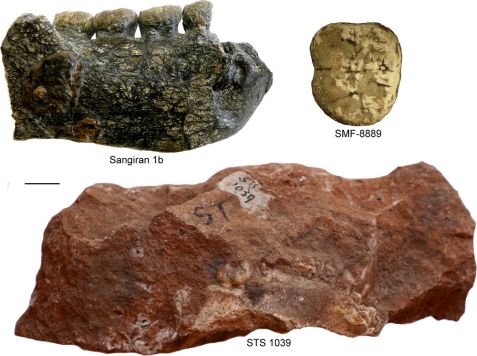MLZ is a cooperation between:
 > Technische Universität München
> Technische Universität München > Helmholtz-Zentrum Hereon
> Helmholtz-Zentrum Hereon
 > Forschungszentrum Jülich
> Forschungszentrum Jülich
MLZ is a member of:
 > LENS
> LENS > ERF-AISBL
> ERF-AISBL
MLZ on social media:

MLZ (eng)
Lichtenbergstr.1
85748 Garching
Bildgebung mit Neutronen in der Kulturerbeforschung
Bildgebung mit Neutronen in der Kulturerbeforschung

On the upper left is the lower jaw of the early man from Java, on the upper right the fossil orangutan tooth is to be seen and the rock below contains the upper jaw of the long-tailed monkey. Scale: 1cm. © C. Zanolli
X-ray scanners are available in many museums and research centers, so they are always first choice for the examination of cultural heritage objects. However, X-rays fail when metal objects with organic matter inside (e.g., religious relics), or bones in chalk rock or even when ferrous clastic terrestrial deposits (“red beds”) need to be examined.
Neutron Imaging is ideally suited for applications in cultural heritage even at small reactors with moderate image resolution. However, recently, high resolution imaging is being increasingly used for advanced studies, especially in paleontology. The special contrast for hydrogen and between neighboring elements in the periodic system allows for new applications that are not accessible for X-rays, like organic material in enclosed containers made of ceramics or metals, fossilized bones in chalk rock or in ferrous “red” beds, and even for animal and hominid teeth. Fission neutrons permit the examination of large samples that otherwise show large attenuation for thermal neutrons.
Neutrons also deliver a contrast between many neighboring elements in the periodic system, often rendering contrast between very similar materials like enamel and dentine in fossil teeth. Cold neutrons are employed at the ANTARES facility, and fission neutrons are available at the NECTAR facility to penetrate large samples.
Read more details: Burkhard Schillinger, Amélie Beaudet, Anna Fedrigo, Francesco Grazzi, Ottmar Kullmer, Michael Laaß, Malgorzata Makowska, Ingmar Werneburg and Clément Zanolli, Neutron Imaging in Cultural Heritage Research at the FRM II Reactor of the Heinz Maier-Leibnitz Center; Journal of Imaging 4(1), 22 (2018)
MLZ is a cooperation between:
 > Technische Universität München
> Technische Universität München > Helmholtz-Zentrum Hereon
> Helmholtz-Zentrum Hereon
 > Forschungszentrum Jülich
> Forschungszentrum Jülich
MLZ is a member of:
 > LENS
> LENS > ERF-AISBL
> ERF-AISBL
MLZ on social media:


